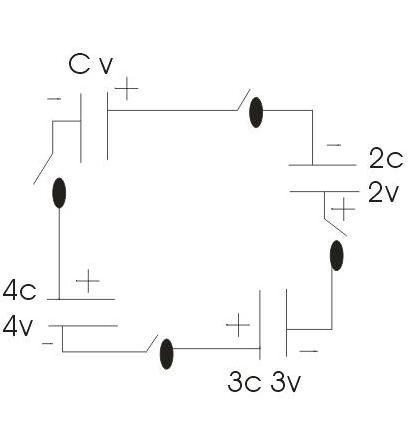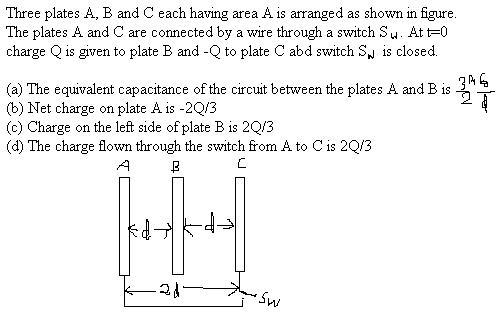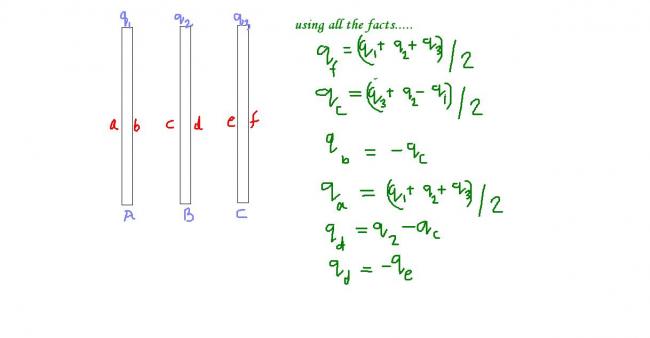 11
11http://targetiit.com/iit-jee-forum/posts/pls-help-me-in-this-12373.html
(i) While distributing the charges on different faces, we should use the fact that two opposite faces have equal and opposite charges on them.[Gauss's Law]
(ii) In an electrostatically Isolated system, the net charges on plate A and C is zero.
(iii) Further A and C are at the same potential, therefore, VB -VA = VB - VC
(iv) Electric field inside any conducting plate (say inside C ) = 0
 106
106Tushar,
I know all that.. just cant seem to apply all this to that .. If I do according to this .. i get none of the options as correct.
If you can possibly show the steps it wud be gr8
 106
106debo. but here,
Va = Vc is the condition. So q(a) = q(f) = 0 naa ??
pls recheck .. regarding this question specifically
i know the general distribution .. agar woh hota, then i would not have posted this question
 1
1i dont know but my answers coming absurd
assuming the charges from the left to right side
on the 1st plate
on the 1 plate +q1
right plate =-q1
on the middle plate
left side q1
rite side =q-q1
on the 3 plate
left side q
right side=-(Q=q1)
now the V at plate 1=at plate 3
V at plate 1
Q/d-Q/2d=Q/2d
V at plate 3
Q/d
therefore Q=0 i hv purposely solved till here only u can confirm ......
 106
106According to the answrs provided.. all the options are correct.. so according to them ur answer is wrong
 1
1
Capacitors with capacities C, 2C, 3C and 4C are charged to Voltage V,2V,3V and 4V correspondingly.The circuit is closed. Find the voltage on all capacitors in equilibrium.
Pls. post answer fast.
 1
1initially charges on capacitors are
CV , 4CV,9CV AND 16CV resp
AFTER CLOSING THE CIRCUIT
let charges on these capacitors are
q1,q2,q3,q4
by charge conservation
-q1 +q4 =-CV +16CV =15CV.............<1>
q1 -q2 =CV - 4CV = -3CV..............<2>
-q4 +q3 =-16CV +9CV = -7CV.........<3>
q2 -q3 =4CV - 9CV =-5CV.............<4>
 1
1u cant solve it this way because on trying to solve any 2 variables at a time ull get two similar equations which cancel each other out
 23
23
q2 = (Vb -Va) 2C
q2/2 = (Vb -Va) C ...(1)
q1 = ( Va - Vd)C ....(2)
q3 = (Vc - Vb)3C
q3/3 = (Vc - Vb)C.....(3)
q4 = ( Vd - Vc )4 C
q4 /4= ( Vd - Vc ) C ....(4)
add (1), (2), (3),(4)
thus q1 + q2/2 +q3/3 + q4/4 =0
12q1 + 6q2 + 4q3 + 3q4 = 0 ...(5)
also by charge conservation
q1 - q2 = -3Q .....(6)
q2 - q3 = -5Q.....(7)
q3 - q4 = -7 Q.....(8)
q4 - q1 = 15 Q.....(9)
solve (5) and (6),(7),(8),(9)
we get q1= -3.8Q
i.e q1 = -3.8CV
q2 = -0.8CV
q3= 4CV
q4=11.2CV
now PD can be easily found out
 1
1Ans:-19/5 V, -2/5 V, 7/5 V, 14/5 V
 23
23q1/C = -3.8CV/1C = -19/5 V
q2/2C= -0.8CV/2C = - 0.4 = -2/5 V
q3/3C = 4CV/3C=4/3 V
q4/4C = 11.2CV/4C = 14/5 V
dude V1, V2,V4 to sahi hai , to fir y is V3 coming wrong ??



